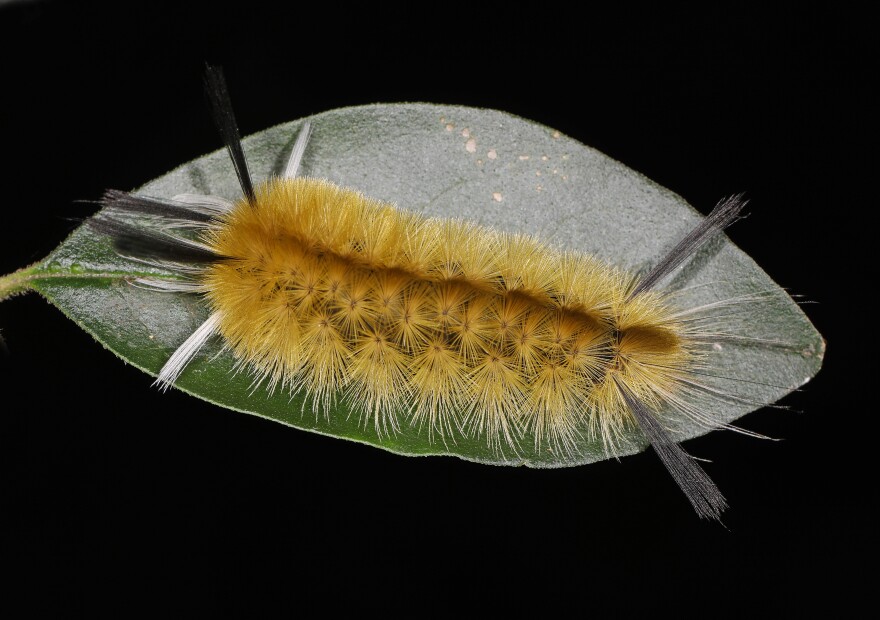Every other Friday on Morning Edition NHPR’s Sam Evans-Brown tracks down answers to questions about the environment and outdoors for our listeners in a segment we call “Ask Sam.”
Christin in Hopkinton asks: “I have been a trail runner for quite some time. But this year there seems to be caterpillars just hanging in the middle of the air. I’ve never, ever experienced this. It’s not as if a spider has them in their web, they’re just suspended... Obviously I’m only seeing it in the woods, so I’m guessing they're suspended from a tree by some invisible strand of some sort, but I don’t remember this happening before where I’m dodging them left and right. So I’m curious, what’s up with the caterpillars and why?"
Normally, this question would be one that I might skip, because it doesn’t have enough detail to identify the caterpillar in question, but given that Hopkinton is just one town over from Concord, I have been noticing the exact same phenomenon, and was already half way to answering the question by the time we got it.
These fuzzy friends that we are noticing are called the banded tussock moth caterpillar. They’re just sort of your run-of-the-mill fuzzy caterpillars. They have chemical defenses, as do many of the fuzzy caterpillars, which means if you touch one it may give you a rash.
I had goofed around with a very nifty smartphone app called iNaturalist to identify these little guys, and wouldn’t you know it, iNaturalist shows a huge spike in the number of observations of these caterpillars this year.
Last year in September and August only 30 were uploaded versus 110 so far this year, and September isn’t even finished. To a certain extent that’s because more people are using the app, but if you look at the same numbers for Vermont, there isn’t a big spike.
So this bug boom *could be* real.
So what’s up with the caterpillars?
To get some answers I reached out to JoAnne Russo, a Citizen Scientist and iNaturalist superstar moth identifier, from just over the river in Saxton’s River, Vermont.
First Question: What’s with the dangling? She explained it could be two things.
First, it could be something called ballooning.
“So what happens is as they get bigger they want to move around, and the quickest way to move around is to drop on this strand and the wind will blow them to another leaf somewhere,” Russo explains.

They may also simply be lowering themselves down in order to walk along the forest floor to a new spot.
“They also do it to protect themselves from predators. A bird is going to go into a tree and start looking on the undersides of leaves for caterpillars to eat,” says Russo, “So they don’t notice anything that’s hanging on the threads.”
That’s the most likely explanation for the caterpillars that are just hanging and not raising or lowering themselves.
But WHAT’S UP with ALL THE CATERPILLARS?
I’ve been dodging the root question here, which is why are there so many of them that we’re noticing them this year? I’m afraid we don’t have a great answer for that one.
“There’s a lot of years were a particular caterpillar or more is eruptive… so there’s a lot of them,” says Russo, speculating that perhaps the fact that it was dry-ish in the few months the adult moths were laying eggs could be an explanation, “I think it was just a really good year.”
If you spend any time talking to scientists (citizen or otherwise) who study insects, you quickly realize we know VERY little about them, in general. That becomes particularly true when it comes to species-specific abundance estimates, which – apart from a few flagship species – are almost non-existent.
This means when it comes to the million or so species of arthropods out there, we don’t really know if their numbers are rising or falling or why. Which is why, these citizen science apps like iNaturalist are so exciting. Enough people using them means that for the first time ever, we might get a glimpse into the population dynamics of the many bugs that surround us.
Sam Evans-Brown, is host of NHPR’s Outside/In which you can subscribe to where-ever you get your podcasts. If you’d like to submit a question you can record it as a voice memo on your smartphone and send it to oustidein@nhpr.org, OR call the hotline, 1-844-GO-OTTER, OR submit it here.








